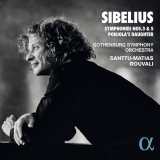Kein Zweifel: Der Finne Santtu-Matias Rouvali hat den Schlüssel zum Universum seines Landsmanns Sibelius. Er hat die beiden Symphonien dramaturgisch wie auch technisch im Griff. Die spezifische Atmosphäre dieser Musik stellt sich ganz selbstverständlich ein. Rouvali bemüht sich, die zwei Werke mit gestischen, klangintensiven, kraftvollen Darstellungen wirkungsvoll zu Gehör zu bringen. Sein Sibelius spricht keine nüchterne, sondern eine ausdrucksstarke, manchmal sogar sehr gefühlvolle Sprache. Eine feine Abstimmung und Abstufung zwischen den einzelnen Instrumentengruppen lassen die polyphone Transparenz und den Klangreichtum der Kompositionen voll zur Geltung kommen. Es ist schon faszinierend, wie der Dirigent Steigerungen aufzubauen versteht, wie er Kräfte gegeneinander stellt und damit eine einzigartige Wirkung erzielt. Gleichzeitig gibt Rouvali der Musik mit warmen Farben einen sehr schönen, romantischen Charakter, der sich von den mehr mystischen Interpretationen unterscheidet und auch die volkstümlichen Elemente stärker betont. Insbesondere die Fünfte ist sehr individuell und eben ‘anders’ geraten. Bei Rouvali wird Sibelius menschlicher.
Die Intensität und Energie der Rouvali-Interpretationen findet sich auch in der dramatisch aufgeheizten Tondichtung Pohjolas Tochter, in der gleichzeitig Rouvalis erklärte Liebe für die Natur deutlich wird. Das bringt Farben in die Musik, die man sonst nicht so hört.
Das Gothenburg Symphony Orchestra stellt erneut seine hohe Spielkultur unter Beweis. Der Klang ist – aufnahmetechnisch gesehen – groß dimensioniert und angenehm räumlich. Alles in allem: eine exzellente Sibelius-Platte, die im Angebot eine Spitzenstellung einnimmt.
No doubt: The Finn Santtu-Matias Rouvali has the key to the universe of his compatriot Sibelius. He has the two symphonies dramaturgically as well as technically under control. The specific atmosphere of this music arises quite naturally. Rouvali labored to make the two works heard effectively with gestural, sonorous, powerful performances. His Sibelius does not speak a sober, but an expressive, sometimes even very soulful language. Fine tuning and gradation between the individual instrumental groups allow the polyphonic transparency and richness of sound of the compositions to be fully appreciated. It is quite fascinating how the conductor knows how to build up climaxes, how he juxtaposes forces and thus achieves a unique effect. At the same time, Rouvali gives the music a very beautiful, romantic character with warm colors, which differs from the more mystical interpretations and also emphasizes the folk elements more strongly. Especially the Fifth is very individual and just ‘different’. With Rouvali, Sibelius becomes more human.
The intensity and energy of Rouvali’s interpretations can also be found in the dramatically heated tone poem Pohjola’s Daughter, in which Rouvali’s declared love for nature becomes clear at the same time. This brings colors to the music not usually heard.
The Gothenburg Symphony Orchestra once again demonstrates its high level of playing. The sound is – in recording terms – large in scale and pleasantly spacious. All in all: an excellent Sibelius disc that occupies a top position in the range.
























